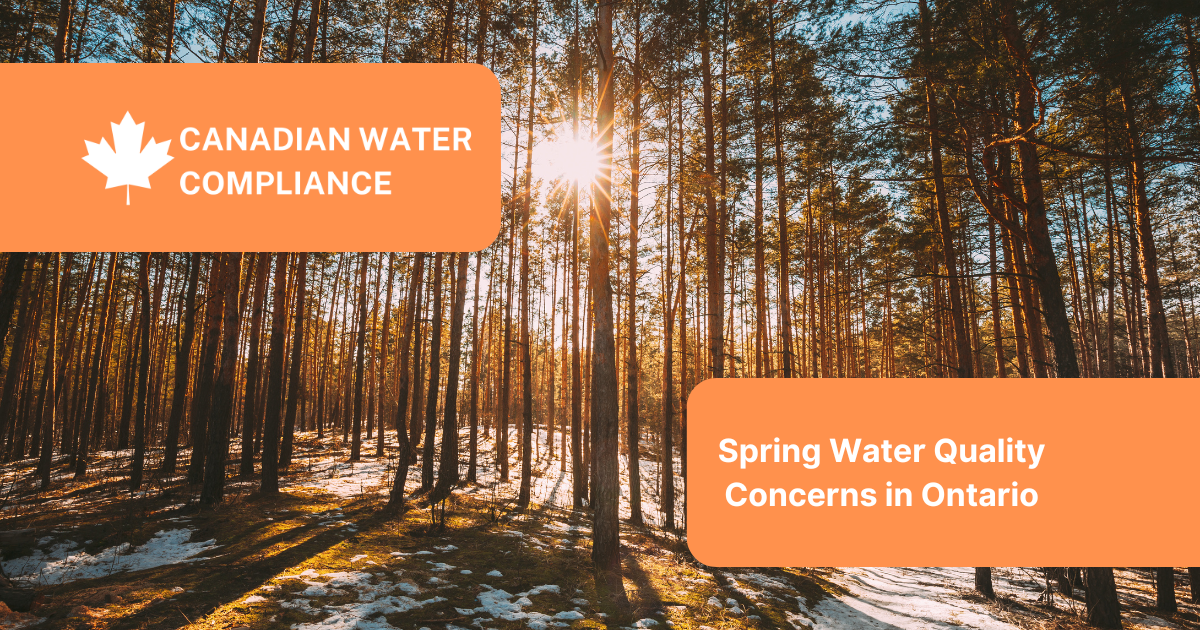
Written By: Canadian Water Compliance | On
Spring in Ontario marks the transition from freezing temperatures to warmer, wetter conditions. While the season brings longer days and melting snow, it also presents unique challenges for water quality. Increased runoff, flooding, and seasonal maintenance activities can introduce contaminants into drinking water sources, affecting homeowners, businesses, and industries alike.
In this guide, we’ll cover:
✔ The effects of spring thaw and runoff on water quality
✔ Increased risks for private well owners and municipalities
✔ The dangers of Legionella bacteria in cooling towers during startup
✔ How to ensure safe drinking water this season
As snow and ice melt, water carries accumulated pollutants from roads, fields, and urban areas into lakes, rivers, and groundwater supplies. This can introduce:
🔹 Road Salt & Chemicals – High concentrations of chloride from winter road salt can affect drinking water taste and corrode plumbing.
🔹 Bacteria & Pathogens – Animal waste, sewage overflows, and stagnant water create a higher risk of E. coli and other harmful bacteria.
🔹 Pesticides & Fertilizers – Runoff from agricultural lands can increase nitrate levels in well water, posing health risks.
🔹 Sediment & Debris – Increased turbidity can reduce water clarity and affect treatment processes.
If you rely on a private well, spring runoff can introduce contaminants that aren’t typically present in the winter months. Ontario’s Ministry of Health recommends testing well water at least three times a year, with spring being a crucial period.
✅ Test for bacteria (E. coli, coliforms), nitrates, and heavy metals after snowmelt or heavy rainfall.
✅ Inspect your well for cracks or damage that could allow surface water contamination.
✅ Consider shock chlorination if bacteria are detected in your results.
As temperatures rise, many buildings restart cooling towers, HVAC systems, and industrial water systems that were dormant over the winter. This startup process creates an ideal environment for Legionella bacteria growth, which can lead to Legionnaires’ disease, a severe type of pneumonia.
🏢 Industries & Facilities at Higher Risk:
✔ Hotels, office buildings, and hospitals
✔ Manufacturing facilities with cooling systems
✔ Apartment buildings with large plumbing systems
How to Prevent Legionella Growth in the Spring:
🔹 Perform comprehensive water testing before reactivating water systems.
🔹 Conduct shock disinfection or flushing of stagnant water lines.
🔹 Maintain water temperatures that prevent bacterial growth (hot water above 60°C and cold water below 20°C).
🔹 Follow Ontario’s Occupational Health & Safety Act guidelines for Legionella risk management.
Whether you own a home, manage a business, or oversee a large facility, proactive water management is essential in the spring. Here’s what you can do:
✔ Schedule Seasonal Water Testing – Ensure drinking water, well water, and industrial water systems meet safety standards.
✔ Monitor Water Quality Reports – Municipalities publish regular updates on water conditions.
✔ Maintain Water Treatment Systems – Change filters, disinfect pipes, and inspect softeners or purifiers.
✔ Be Aware of Flooding Risks – If flooding occurs near your well or water supply, test your water immediately.
Spring brings renewal, but also increased risks for water contamination in Ontario. By understanding seasonal challenges and taking preventive measures, homeowners and businesses can safeguard their water quality and avoid costly issues.
📞 Need professional water testing this spring?
Contact Canadian Water Compliance today for expert assessments and customized water treatment solutions!